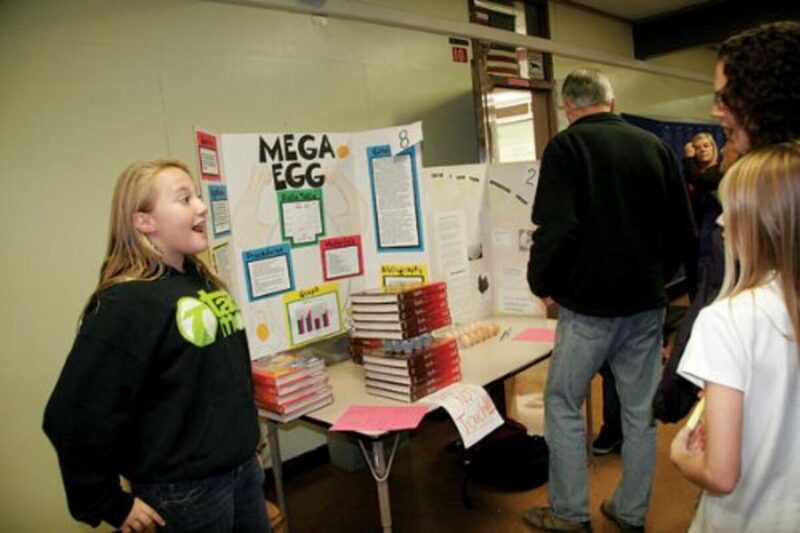Scott Swanson
The Sweet Home Junior High eighth-graders’ Science Fair Wednesday, Nov. 9, presented visitors with a mathematical challenge: how to squeeze visits to the spproximately 80 exhibits into the allotted hour and a half.
As it turned out, that was the most difficult part as the young scientists explained and demonstrated their experiments to a parade of visitors through the evening.
On the lawn next to the parking lot, Shelby Dinsfriend showed off her home-made solar heater, which tested whether soda cans taped together in vertical columns and painted black, with empty space separating them, on one side of the heater produced more heat than similar columns with bricks between them. Passers-by stuck their hands into test boxes on top of the heater and agreed that the bricks side was hotter.
“On really, really sunny days it can get up to 120 degrees,” said Shelby, whose seventh-grade brother Quinn helped her put the contraption together. She said she got her idea from her father, who, she said, is interested in solar heating. Apparently her project impressed a lot of the visitors, who were asked to fill out scorecards as they walked through the displays. Shelby’s won Best in Show.
Other winners were:
n Best Display – Ashlyn Holley and Serenity Blevins, for a project on how well plants grow when fed certain substances – such as Monster.
n Best Presenter – Tyrel Miller, for a project about aerodynamics – how to shape a plane to best reduce drag.
n Most Frequented Booth – Aaron Blanchard and Steen Davis, for a project on pheromones (attracting the opposite sex and female preference to odor), which attracted the most visitors of any booth.
n Einstein Award – Jaeric Cvitarich, for a project on how ultraviolet rays affect bacteria.
Another exhibit, staffed by Michael Voikers and Cody McPhersen, tested whether slimes made from cornstarch mixed with (1) Pepsi, (2) Mountain Dew or (3) Orange Crush would flow faster through a funnel. Michael said they expected the Mountain Dew to produce the fastest-moving slime, but it turned out that Pepsi produced the best mix.
“What was interesting was Pepsi had less sugar,” he said. “Maybe the sugar interacted with the cornstarch and backed up faster.”
Inside, past the boys’ exhibit, the hallway and several classrooms were jammed with students and visitors crowded around projects ranging from tsunami wave experiments to whether rats found food more quickly in cold weather or normal inside room temperatures (warmth seemed to speed things up).
Jacquline Ohmer’s project tested how people responded to different genres of music – hard rock by Black Veil Brides, pop rock by Never Shout Never, classical composer Claude Debussy’s musical depiction of moonlight “Clair de Lune,” rapper Eminem and electro-pop star Ke$ha.
Ohmer said she took heart rate and blood pressure measurements and administered a test for anxiety to determine how people were responding as they listened to the different musical styles.
“I thought they would be most relaxed when they listened to “Clair de Lune,” she said. “I was really surprised by the results. They were most relaxed when they listened to Black Veil Brides and Never Shout Never.”
Nearby, Kaylene Wolfe measured which liquids made experiment subjects’ mouths water more: water, milk, apple cider vinegar, lemon juice or Monster. Monster was king, she said.
Kelsie Jackson created fake fossils like the ones often seen in the sand in museums, he said. His question was what concoction of water and clay made most realistic fossils.
“Following directions” was the solution, he said.
Denacia Price tested whether mold grew faster on white or whole wheat bread and whether that happened more quickly at “pantry” temperature, in the refrigerator or in the freezer. Her experiment showed that white bread stored in a pantry tended to grow mold the fastest, she said.
Egan Shamek and Jake Long’s science project tested chickens’ reaction to artificial food after they’d had a steady diet of regular, organic poultry feed. They discovered that chickens don’t like change; egg production fell off with the birds introduced to new food.
Next door, Maddy Hawken enthusiastically summoned passers-by to stop and see hers and Melanie Jones’ experiment, which compared the strength of eggs that were raw against those that had been soft-boiled and hard-boiled and were supporting weight. She found that the longer the egg was cooked, the more structurally weaker it became.
“That’s because water is being pushed out of the shell, opening the pores,” Maddy said.
Near the end of the line of projects was Julian Hesberg, who, with partner Makenna Ashton, tested Gummi Bears to see which of a number of liquids – tap water, salt water, Sierra Mist, vinegar, bleach and gasoline – would cause the candy to swell the most during a two-hour time trial.
“I expected tap water or salt water to do it, but it was the gasoline,” Julian said, noting that the Gummi Bears increased from 2 centimeters in thickness to 5. The second-most swelling, he said, was tap water, which increased the size from 2 to 3.4 centimeters.
How about the rest?
“The bleach and the vinegar dissolved the Gummi Bears,” Julian said.





